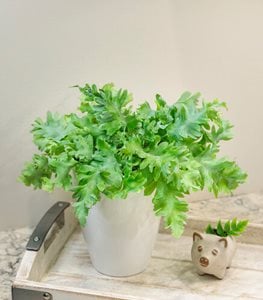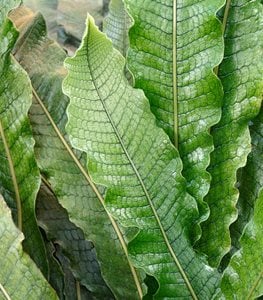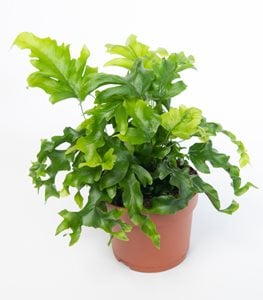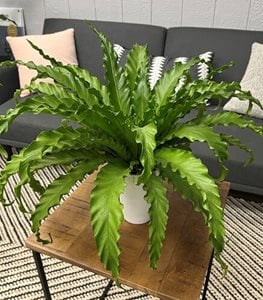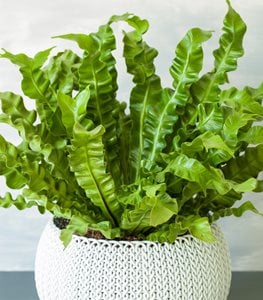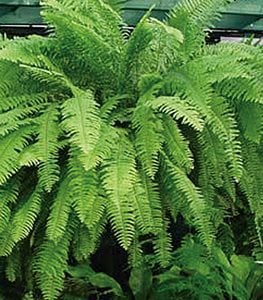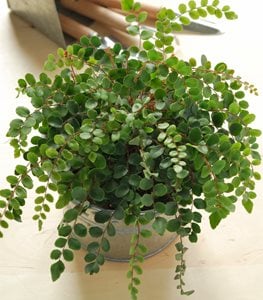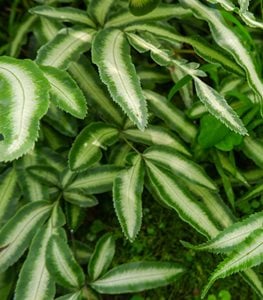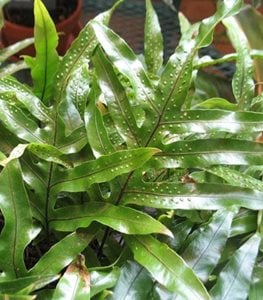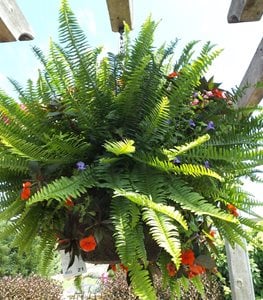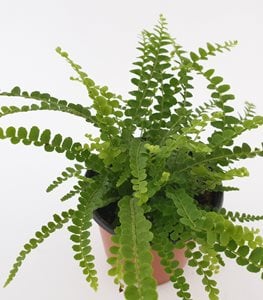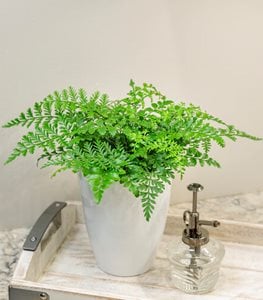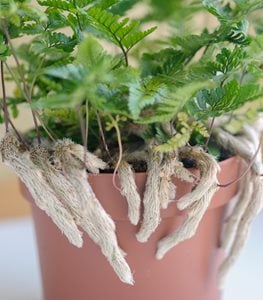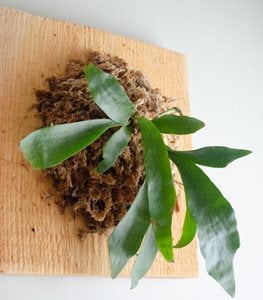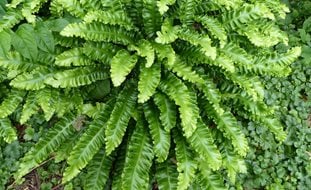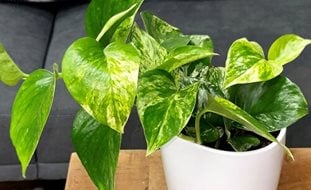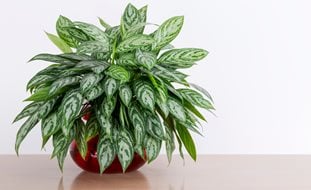14 Best Indoor Ferns to Grow
Grow houseplant ferns to add beauty and elegance to your home or office. Published 10/26/2022Ferns are valued for their attractive foliage and ability to thrive in low-light conditions. Many fern types, particularly those from tropical and semi-tropical regions, can be grown as houseplants.
When given the right conditions, ferns grown indoors are undemanding and low-maintenance. Here are some of the best easy-to-grow indoor ferns for your home or office, along with some indoor growing tips.
On this page: Types of Indoor Ferns | Growing Ferns Indoors
On this page:
TYPES OF INDOOR FERNS
Here are some different varieties of fern plants for indoors:
BLUE STAR FERN (Phlebodium aureum)
Habit: Mounding arching habit
Height/Spread: 10 to 14 inches tall, 16 inches wide
Exposure: Low to medium light
Fronds are ruffled and scalloped, forming a dense compact clump. New leaves are pale green, developing a blue-green patina as they age. Blue star fern is an epiphyte with fuzzy creeping rhizomes that emerge from the base. Use as a tabletop decoration for an office or a humid area such as a bathroom.
CROCODILE FERN (Microsorum musifolium)
Habit: Mounding habit
Height/Spread: 1 to 2 feet tall, 3 to 5 feet wide; will stay smaller indoors
Exposure: Bright filtered light from a north or eastern window
Also known as alligator fern, this variety is named for the distinctive green veining that forms a crocodile-like pattern on the foliage. The strappy fronds are glossy green with darker green veins. This epiphyte forms dense rhizomes just beneath the soil surface from which new leaves emerge. Provide good drainage and a humid environment.
FOOTED FERN (Phlebosia hybrid)
Habit: Mounding habit
Height/Spread: 10 to 20 inches tall, up to 34 inches wide
Exposure: Low to medium light
This rare hybrid fern produces wavy green foliage with deeply dissected leaves. This epiphyte spreads by fuzzy creeping rhizomes from which new leaves emerge. Prefers high humidity but is more tolerant of variable humidity than some other ferns. Display on a desktop or in a hanging basket.
JAPANESE BIRD'S NEST FERN (Asplenium antiquum)
Habit: Mounding arching habit
Height/Spread: 1 to 2 feet tall, 12 to 18 inches wide
Exposure: Low to medium light
Glossy bright green leaves with wavy edges grow into a uniform rosette with a nest-like center, hence the common name. The palm-like shape is attractive when displayed as a tabletop specimen in an office or living room. Provide good drainage for this epiphyte and place in a north facing window or other low light area.
BIRD'S NEST FERN (Asplenium nidus)
Habit: Vase-shaped habit
Height/Spread: 3 to 5 feet tall, 2 to 3 feet wide
Exposure: Bright indirect light
Bright green fronds with dark midribs form a rosette with a nest-like center, hence the common name. The foliage is wavy along the edges and not dissected like most ferns, giving a robust appearance. Epiphytic in its natural habitat, this tropical evergreen fern is most often grown as a potted houseplant, with fronds up to 2 feet long.
BOSTON FERN (Nephrolepis exaltata)
Habit: Mounding arching habit
Height/Spread: 2 to 3 feet tall and wide
Exposure: Bright indirect light indoors, partial sun to shade when outdoors
Boston fern is characterized by dissected lance-shaped green leaves and a uniform mounding habit. Popularized during the Victorian era, this tropical evergreen fern is grown as a houseplant and commonly displayed outdoors during summer in hanging baskets or containers.
BUTTON FERN (Pellaea rotundifolia)
Habit: Mounding habit
Height/Spread: 12 to 18 inches tall and wide
Exposure: Bright indirect light
Button fern is a New Zealand native with tiny button-shaped leaflets that occur along the entire length of the delicate stems. The arching fronds can reach up to 18 inches long, while the green leaf stalks turn dark red as they age. This petite evergreen fern can be displayed as a tabletop accent, in a hanging basket or decorative pot.
CRETAN BRAKE FERN (Pteris cretica)
Habit: Upright clumping habit
Height/Spread: 18 to 24 inches tall and wide
Exposure: Bright indirect light
Also known as ribbon fern, this striking variegated fern has pale gray-green fronds with bold white stripes at the center. The deeply dissected finger-like leaves and open airy habit create a graceful elegant appearance. Display on a shelf or tabletop. Plants can be placed outdoors in a shady spot during warmer months.
KANGAROO FERN (Phymatosorus diversifolius)
Habit: Compact spreading habit
Height/Spread: 1 foot tall, 2 to 4 feet wide
Exposure: Medium to bright indirect light
Also known as kangaroo paw fern, this evergreen fern has glossy dark green fronds which resemble a kangaroo footprint. Epiphytic in its native habit of Australia and New Zealand, kangaroo fern spreads by furry rhizomes, and can be trained as a climber. Allow to trail in hanging baskets, train up a moss pole or display as a tabletop specimen.
KIMBERLY QUEEN FERN (Nephrolepis obliterata)
Habit: Mounding arching habit
Height/Spread: 2 to 3 feet tall and wide
Exposure: Bright indirect light
This lush evergreen fern, native to Australia, is characterized by deeply dissected sword-shaped fronds. The graceful arching habit makes this fern suitable to grow in hanging baskets or as a tabletop specimen. Plants can be placed outdoors in warmer months. Provide high humidity to prevent browning of leaves.
LEMON BUTTON FERN (Nephrolepis cordifolia)
Habit: Compound arching habit
Height/Spread: 12 inches tall and wide
Exposure: Low to bright indirect light
Lemon button fern is similar to Boston fern, but with rounded button-like leaflets that grow the entire length of the long sword-like fronds. The foliage emits a light lemony scent, helping to refresh indoor air. Plant in a terrarium or display on a desk or tabletop. Plants are more tolerant of neglect than other ferns. Can be grown outdoors as a tender perennial in USDA zones 8-10.
MOTHER FERN (Asplenium bulbiferum)
Habit: Upright arching habitHeight/Spread: 3 to 4 feet tall, 2 to 3 feet wide
Exposure: Partial to full shade
Mother fern is named for the offsets on the foliage that fall to the ground to produce new plants. Finely cut evergreen fronds have a feathery texture that complements the graceful arching habit. Grow this New Zealand native fern in a hanging basket or display on an office desk or living room table. Can also be grown outdoors as a tender perennial in USDA zones 9-11.
RABBIT'S FOOT FERN (Davallia fejeensis)
Habit: Mounding habitHeight/Spread: 1 to 2 feet tall and wide
Exposure: Moderate to bright indirect light
Named for the fuzzy brown rhizomes that resemble rabbit’s feet, this epiphyte has broad, deeply dissected fronds that grow in a triangular shape. Native to Fiji, rabbit’s foot fern can be grown in a hanging basket or on a wall mounted plaque to showcase the trailing rhizomes. Display in a shallow pot on a desk or tabletop.
STAGHORN FERN (Platycerium bifurcatum)
Habit: Spreading habitHeight/Spread: 2 to 3 feet tall and wide
Exposure: Partial to full shade
Staghorn fern, named for the thick green fronds that grow in an antler-like structure, is a slow growing epiphyte typically grown on a plaque. This tropical, native to Australia and Asia, is slow growing, but becomes an impressive size once it reaches maturity. Display as a decorative accent on a wall or fence outdoors in warmer months and overwinter indoors as a houseplant.
GROWING FERNS INDOORS
There are many types of indoor ferns. Some can be placed outdoors during warmer months. When given the right conditions, indoor fern plants are easy to grow. Needs vary depending on the variety, so research individual ferns to make sure you are giving them the best care. Here are some basic fern houseplant growing tips:
Containers: Pots should be slightly larger than the root ball, with adequate drainage holes.
Soil: Indoor ferns grow best in a high-quality, all-purpose potting mix. For epiphytes, use a soilless medium such as charcoal, sphagnum moss, fir bark, or cocoa coir, or a pre-made orchid potting mix.
Light: Ferns generally prefer bright indirect light. Place near a bright window or under artificial lights. Avoid direct sunlight to prevent leaf scald.
Water: Most ferns prefer regular moisture. Water when the top 1 inch of the soil is dry. Don’t overwater to prevent root rot.
Fertilize: Indoor ferns benefit from some fertilizer to keep their foliage a healthy green. Feed with an all-purpose, water-soluble fertilizer or fish emulsion at half strength once a month during the growing season. Cease fertilizing during winter months when plants go semi-dormant.
Temperature: Keep indoor temperatures moderately warm, between 60 to 72 degrees F. Protect plants from sudden temperature changes and cold drafts.
Humidity: Most ferns prefer high humidity. Use a room humidifier, mist your plants frequently, or place pots on a tray of pebbles and water. Don’t allow the bottom of the pot to sit in water to prevent root rot.
Pests and diseases: Inspect plants frequently for signs of pests or diseases. Treat symptoms accordingly. (See more on common houseplant pests.)
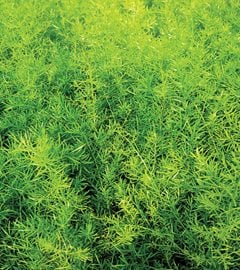
Photo by Proven Winners
WHAT ABOUT ASPARAGUS FERN?
While not a true fern, asparagus fern (Asparagus spp.) is grown for its feathery green leaves that create an airy effect. This tender herbaceous perennial can be grown outdoors year-round in frost-free zones, treated as an annual in colder zones, or grown as a houseplant. Display in a hanging basket or container.
Zones: 9-11
Habit: Upright bushy habit
Height/Spread: 1 to 3 feet tall, 1-1/2 to 4 feet wide
Exposure: Partial sun outdoors, bright indirect light indoors
Note: There are several species of asparagus fern, with some listed as highly invasive in many areas when grown outdoors. Check locally to see if this is an issue where you are.
